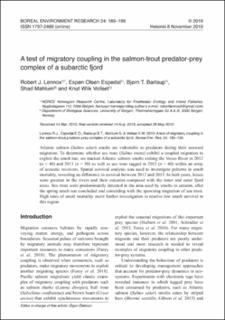| dc.contributor.author | Lennox, Robert J. | |
| dc.contributor.author | Espedal, Espen Olsen | |
| dc.contributor.author | Barlaup, Bjørn Torgeir | |
| dc.contributor.author | Mahlum, Shad Kenneth | |
| dc.contributor.author | Vollset, Knut | |
| dc.date.accessioned | 2020-03-23T11:41:00Z | |
| dc.date.available | 2020-03-23T11:41:00Z | |
| dc.date.created | 2020-01-07T15:18:34Z | |
| dc.date.issued | 2019 | |
| dc.identifier.citation | Boreal environment research. 2019, 24 189-199. | |
| dc.identifier.issn | 1239-6095 | |
| dc.identifier.uri | https://hdl.handle.net/11250/2648098 | |
| dc.description.abstract | Atlantic salmon (Salmo salar) smolts are vulnerable to predators during their seaward migration. To determine whether sea trout (Salmo trutta) exhibit a coupled migration to exploit the smolt run, we tracked Atlantic salmon smolts exiting the Vosso River in 2012 (n = 40) and 2013 (n = 50) as well as sea trout tagged in 2012 (n = 40) within an array of acoustic receivers. Spatial survival analysis was used to investigate patterns in smolt mortality, revealing no difference in survival between 2012 and 2013. In both years, losses were greatest in the rivers and their estuaries compared with the inner and outer fjord areas. Sea trout were predominantly detected in the area used by smolts in autumn, after the spring smolt run concluded and coinciding with the spawning migration of sea trout. High rates of smolt mortality merit further investigation to resolve low smolt survival in this region. | |
| dc.language.iso | eng | |
| dc.title | A test of migratory coupling in the salmon-trout predator-prey complex of a subarctic fjord | |
| dc.type | Peer reviewed | |
| dc.type | Journal article | |
| dc.rights.holder | Copyright 2019 Boreal Environment Research Publishing Board | |
| dc.description.version | publishedVersion | |
| cristin.ispublished | true | |
| cristin.fulltext | original | |
| cristin.qualitycode | 1 | |
| dc.identifier.cristin | 1767868 | |
| dc.source.journal | Boreal environment research | |
| dc.source.volume | 24 | |
| dc.source.pagenumber | 189-199 | |
